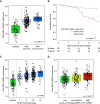Whole-Blood RNA Profiles Associated with Pulmonary Arterial Hypertension and Clinical Outcome
- PMID: 32352834
- PMCID: PMC7427383
- DOI: 10.1164/rccm.202003-0510OC
Whole-Blood RNA Profiles Associated with Pulmonary Arterial Hypertension and Clinical Outcome
Abstract
Rationale: Idiopathic and heritable pulmonary arterial hypertension (PAH) are rare but comprise a genetically heterogeneous patient group. RNA sequencing linked to the underlying genetic architecture can be used to better understand the underlying pathology by identifying key signaling pathways and stratify patients more robustly according to clinical risk.Objectives: To use a three-stage design of RNA discovery, RNA validation and model construction, and model validation to define a set of PAH-associated RNAs and a single summarizing RNA model score. To define genes most likely to be involved in disease development, we performed Mendelian randomization (MR) analysis.Methods: RNA sequencing was performed on whole-blood samples from 359 patients with idiopathic, heritable, and drug-induced PAH and 72 age- and sex-matched healthy volunteers. The score was evaluated against disease severity markers including survival analysis using all-cause mortality from diagnosis. MR used known expression quantitative trait loci and summary statistics from a PAH genome-wide association study.Measurements and Main Results: We identified 507 genes with differential RNA expression in patients with PAH compared with control subjects. A model of 25 RNAs distinguished PAH with 87% accuracy (area under the curve 95% confidence interval: 0.791-0.945) in model validation. The RNA model score was associated with disease severity and long-term survival (P = 4.66 × 10-6) in PAH. MR detected an association between SMAD5 levels and PAH disease susceptibility (odds ratio, 0.317; 95% confidence interval, 0.129-0.776; P = 0.012).Conclusions: A whole-blood RNA signature of PAH, which includes RNAs relevant to disease pathogenesis, associates with disease severity and identifies patients with poor clinical outcomes. Genetic variants associated with lower SMAD5 expression may increase susceptibility to PAH.
Keywords: RNAseq; pulmonary arterial hypertension; whole-blood RNA.
Figures





Comment in
-
Clarifying the Pulmonary Arterial Hypertension Molecular Landscape Using Functional Genetics.Am J Respir Crit Care Med. 2020 Aug 15;202(4):488-490. doi: 10.1164/rccm.202004-1411ED. Am J Respir Crit Care Med. 2020. PMID: 32453600 Free PMC article. No abstract available.
References
-
- Galiè N, Humbert M, Vachiery JL, Gibbs S, Lang I, Torbicki A, et al. 2015 ESC/ERS guidelines for the diagnosis and treatment of pulmonary hypertension: the Joint Task Force for the Diagnosis and Treatment of Pulmonary Hypertension of the European Society of Cardiology (ESC) and the European Respiratory Society (ERS). Endorsed by: association for European Paediatric and Congenital Cardiology (AEPC), International Society for Heart and Lung Transplantation (ISHLT) Eur Respir J. 2015;46:903–975. - PubMed
Publication types
MeSH terms
Substances
Grants and funding
LinkOut - more resources
Full Text Sources
Other Literature Sources

